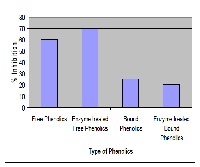Antioxidant activity of free and bound phenolics in Curcuma longa
Keywords:
Antioxidant, Phenolics, Curcuma longaAbstract
The antioxidant activity of free and bound phenolics of turmeric (Curcuma longa) extract prepared by treating with enzyme and without enzyme was analyzed. The enzyme assisted extraction of Curcuma longa showed higher levels of antioxidant activity as evaluated by both free radical scavenging compared to that of non enzyme extracts. Higher level of antioxidant activity in C. longa has been attributed to the phenolic content in them. The free and bound phenolics of enzyme treated extract of C. longa showed high content of phenolic compounds (31.0 and 1.3 mg/g) compared to that of non enzymatic extract (28.8 and 3.5 mg/g). Our studies clearly suggest the presence of potent antioxidants in C. longa.
References
Arts, I.C., Hollman, P.C., 2005. Polyphenols and disease risk in epidemiologic studies. American Journal of Clinical Nutrition 81, 317S–325S.
Peters, U., Poole, C., Arab, L., 2001. Does tea affect cardiovascular disease? A meta-analysis. American Journal of Epidemiology 154, 495–503.
Seeram, N.P., Adams, L.S., Henning, S.M., Niu, Y., Zhang, Y., Nair, M.G., Heber, D., 2005. In vitro antiproliferative, apoptotic and antioxidant activities of punicalagin, ellagic acid and a total pomegranate tannin extract are enhanced in combination with other polyphenols as found in pomegranate juice. The Journal of Nutritional Biochemistry 16, 360–367.
Zhang, A., Chan, P.T., Luk, Y.S., KwokKeung Ho, W., Chen, Z.Y., 1997. Inhibitory effect of jasmine green tea epicatechin isomers on LDLoxidation. The Journal of Nutritional Biochemistry 8, 334–340.
Murcia, M.A., Jimenez, A.M., Martinez-Tome, M., 2001. Evaluation of the antioxidant properties of Mediterranean and tropical fruits compared with common food additives. Journal of Food Protection 64, 2037–2046.
Middleton, E., Kandaswami, C., Theoharides, T.C., 2000. The effects of plant flavonoids on mammalian cells: implications for inflammation, heart disease, and cancer. Pharmacological Reviews 52, 673–751.
Chen. X.G., Shuzo, O., Lt. Y., Han. R. (1998). Inhibition of fernesyl protein transferase, H-rasoncogene expression and p21 ras membrane association by natural products human solid tumor cell lines. Journal natural products Research. 1, 29-51.
Navis I., Sriganth P., Premalatha B. (1999). Dietary curcumin with cisplatin administration modutates tumor marker indices in experimental fbrosarcoma. Pharmacol Res 39, 175-79.
Deshpande, U.R., Gadre S.G., Raste A.S., Pillai D., Bhide S.V., Samuel A.M. (1998). Protective effect of turmeric (Curcuma longa extract of carbon tetrachloride-induced lever damage in rats. Indian journal of Experimental Biology. 36, 573-577.
Purohol A. and Daradka. H.M.M. (1999). Hypolipidaemic effects of curcuma longe (Haldi). in rabbits. Hamadard. 42, 26-29.
Menon V.P. and Sudheer A.R. (2007). Antioxidant and anti-inflammatory properties of curcumin. Adv Exp Med Biol. 595,105-25.
Ramsewak R.S., De Witt D.L., Nair M.G. (2000). Cytotoxicity antioxidant and anti-inflammatory activities of curcumins I-II from Curcuma longa . Phytomedicine. 7, 303-308.
Sreejayan, N., Rao, M. N. A. (1996) Free radical scavenging activity of curcuminoids. Drug Res., 46: 169.
Rajakrishnan V., Menon V.P., Rajashekaran K.N. (1998). Protective role of curcumin ethanol toxicity. Phytotherapy Research, 12, 55-56.
Yoshinobu, K., Yuriko, S., Noriko, W., Yoshiteru, O., Hiroshi, H. (1983) Validity of the oriental medicines. Part 53. Liver protective drugs. Part 8. Antihepatotoxic principles of Curcuma longa rhizomes. Planta Med., 49: 185-187.
Subba Rao, M.V.S.S.T., Murlikrishna, G., 2002. Evaluation of the antioxidant properties of free and bound phenolic acid from native and malted finger millet (Ragi, Eleusine coracana Indaf-15). Journal of Agricultural and Food Chemistry 50, 889–892.
Nordkvist, E., Salomonsso, A., Aman, P., 1984. Distriubution of insoluble bound phenolic acids in barley grain. Journal of the Science of Food and Agriculture 35, 657–661.
Schmeda-Hirschmann, G, Razmilic I, Gutierrez MI, Loyola JI (1999): Proximate composition and biological activity of food plants gathered by Chilean Amerindians. Econ Bot 53:177-187.
Shan, B., Cai, Y. Z., Sun, M. and Corke, H. 2005. Antioxidant capacity of 26 spice extracts and characterization of their phenolic constituents. Journal of the Agricultural and Food Chemistry 53: 7749–7759.
Wong, C., Li, H., Cheng, K. and Chen, F. 2006. A systematic survey of antioxidant activity of 30 Chinese medicinal plants using the ferric reducing antioxidant power assay. Food Chemistry 97: 705-711.
Wu, C.Q., Chen, F., Wang, X., Kim, H.J., He, G.Q., Haley-Zitlin, V. and Huang, G. 2006. Antioxidant constituents in feverfew (Tanacetum parthenium) extract and their chromatographic quantification. Food Chemistry 96: 220–227.



